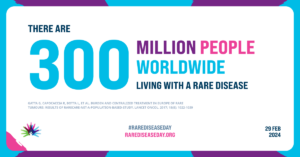
29 Feb Rare Disease Action Plan: What’s in store for 2024

Every year, on the last day of February, the global rare disease community comes together to raise awareness and advocate for positive change for the 300 million people worldwide living with a rare disease. To mark Rare Disease Day, the Department of Health and Social Care have published their third Rare Diseases Action Plan for England, in line with their commitments in the Rare Disease Framework published in 2021.
In a written statement announcing the plan’s publication, Minister of State for Health and Secondary Care Andrew Stephenson said, “Through this third action plan, we will continue to take steps towards achieving our overarching vision – delivering improvements in diagnosis, awareness, treatment and care, and creating lasting positive change for those living with rare diseases.”
For people living with rare diseases, health inequity can remain a significant barrier to better care. Whether it’s the challenge of the diagnostic odyssey, a lack of awareness among healthcare professionals, the requirement to travel further to receive specialist care or the challenge of access to new treatments, coordinated action is needed urgently to address these.
What’s in for 2024?
The 2024 Action Plan includes a progress update on the 29 actions from the previous year’s, as well as setting out 7 new actions. Health equity is the cross-cutting theme in the 2024 plan, with two actions introduced to directly improve health equity and others to support this indirectly. The new actions include the following:
- On health equity, the publication of a toolkit for highly specialised services and a commitment to measure the geographic spread of patients accessing highly specialised services.
- On workforce, the development of a genomics communication skills resource for healthcare professionals and a commitment to develop the specialist genomics workforce through a Genomics Training Academy (GTAC).
- On coordination of care, the implementation of networked models of care for patients with rare diseases to ensure that specialist expertise is always available whilst allowing patients to be treated and cared for as close to home as possible.
- On access to specialist care and treatments, the development of a funding mechanism that incentivises centres to undertake whole body scans on individuals with rare genetic conditions resulting in a predisposition to developing cancer prematurely, and the commitment to conduct a review of the effectiveness of IDAP pilot in supporting access to medical devices.
An update on progress
Building on previous plans and ahead of the publication of this year’s plan, there was anticipation around two key actions relating to improved access to treatments.
Action 25 in the plan was a commitment to review the effectiveness of three schemes that support patient access to innovative treatments; the Early Access to Medicines Scheme (EAMS), the Innovative Licensing and Access Pathway (ILAP) and the Innovative Medicines Fund (IMF).
- On ILAP, the plan notes that as of January 2024, ILAP partners have awarded 44 innovation passports for innovative medicines developed to treat rare diseases. However, there is recognition that ILAP could do more to deliver on its ambition and its partners are currently refreshing the existing operating model with further information expected in quarter one 2024 to 2025.
- On EAMS, the plan highlights that over 700 patients have received a treatment through the EAMS, for 12 different indications, pointing to the success EAMS to support patient access to treatments for SMA.
- On the IMF, the plan states that since its inception in June 2022, there have been 15 rare disease treatments entering the NICE process that were potentially eligible for the IMF, however, for 10 of these, the company did not consider the IMF appropriate. As of January 2024, 4 of 10 rare disease treatments not considered appropriate for the IMF by the company had received a positive recommendation and entered routine commissioning with the appraisal process still in progress for the remaining 6.
Action 13 was a commitment to ensure that the updated NICE methods and processes, published in 2022, were effective in supporting the rapid adoption of medicines for NHS patients with rare diseases. The update notes that due to length of the timeline of the medicines evaluation process, the impact of changes will take some time to assess. It adds that NICE will be in a position to publish the impact of 2022 manual changes in a report by the end of 2024. The plan also goes onto add that in 2024, NICE also plan to review the criteria for determining whether a medicine should be routed to its highly specialised technologies programme for the evaluation of very rare diseases. This is welcome commitment by many stakeholders in the sector.
Looking forwards
Whilst the new actions in this year’s Rare Disease Action Plan for England are welcomed, there is a need to balance this with a sense of urgency in delivery. With 62 Advanced Therapy Medicinal Products, many of which will target rare diseases, expected to be launched in the UK between 2023 and 2027, it is vital that efforts to improve patient access are prioritised swiftly. In a year likely to be bookended by a general election and potential new government, this is ever more important to ensure that progress doesn’t stall and people living with rare diseases receive timely access to the diagnosis, care and treatment that they need.